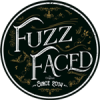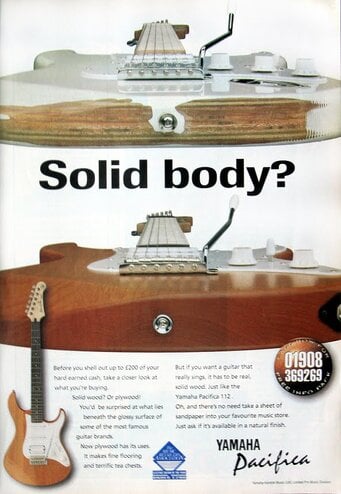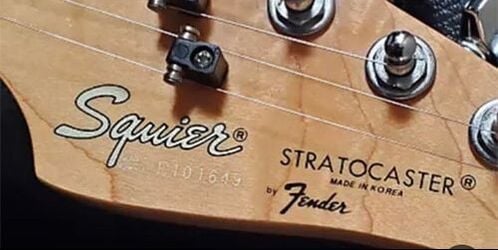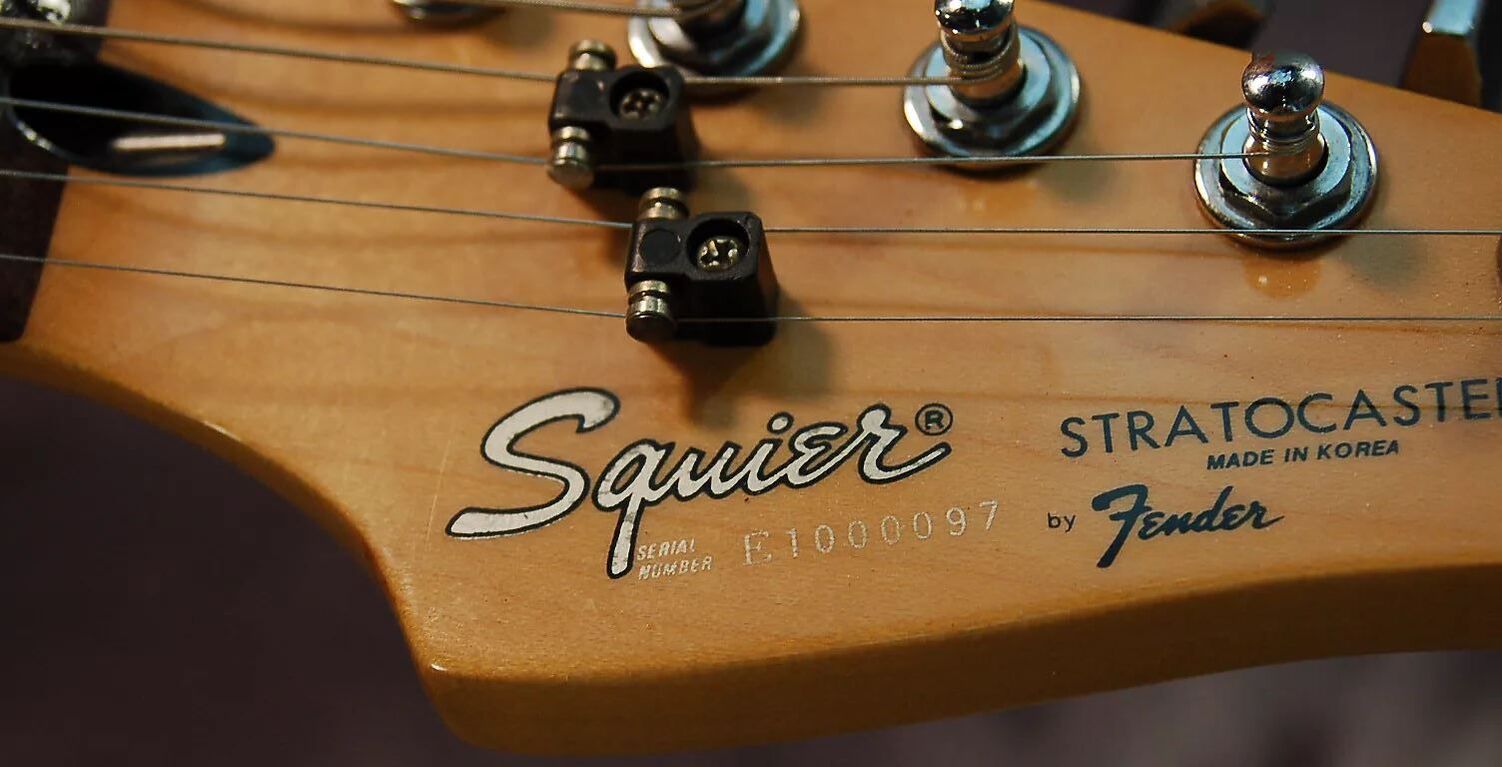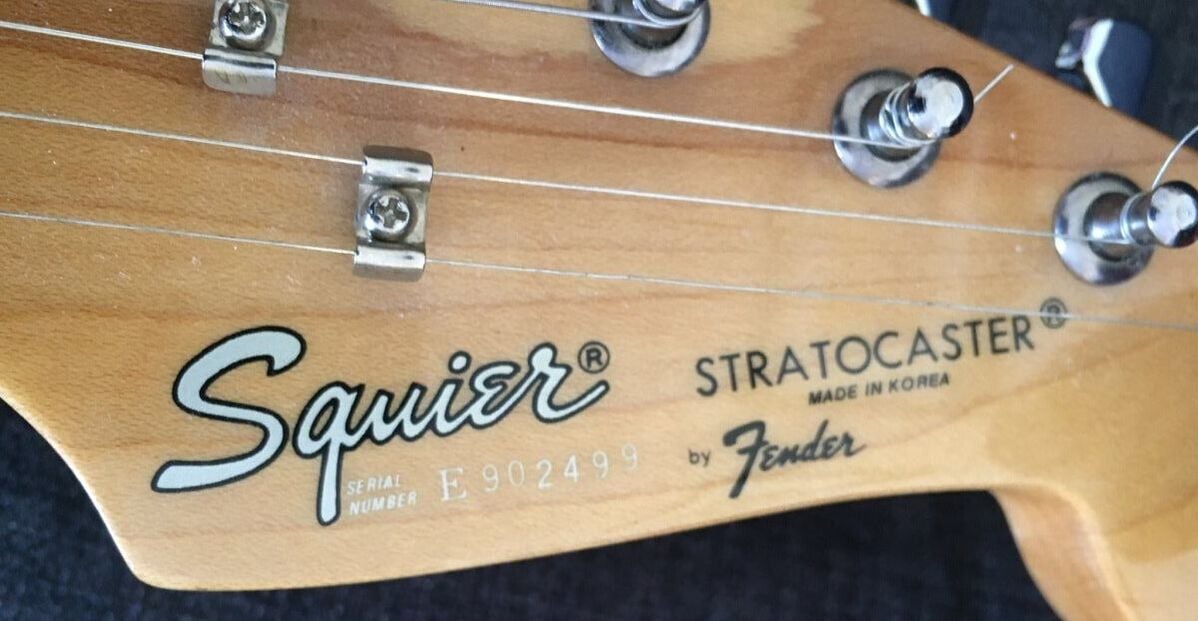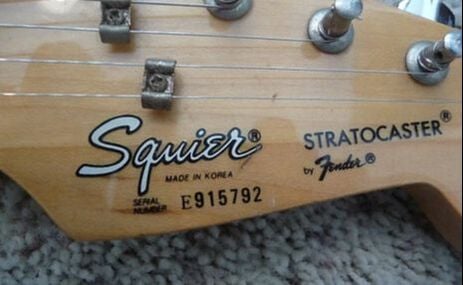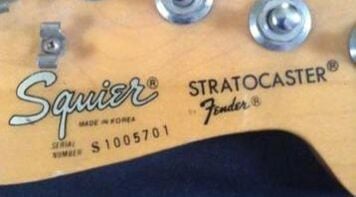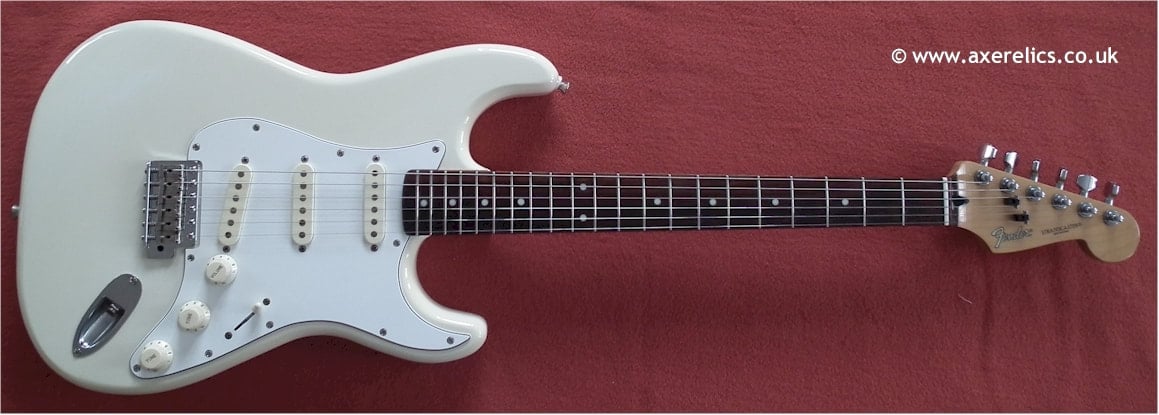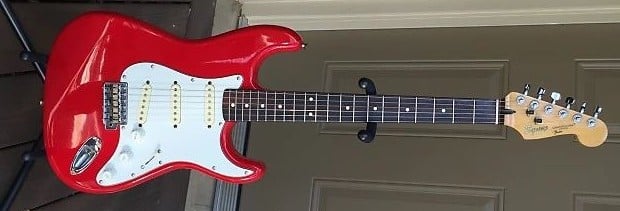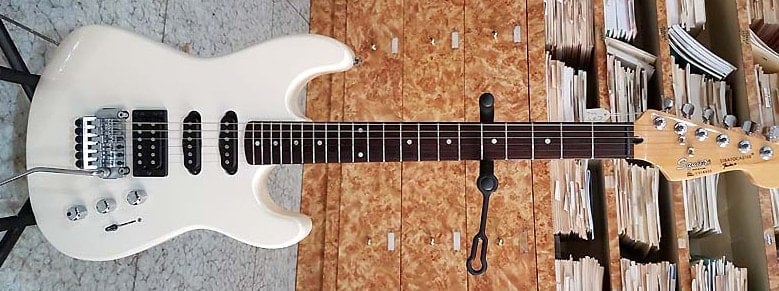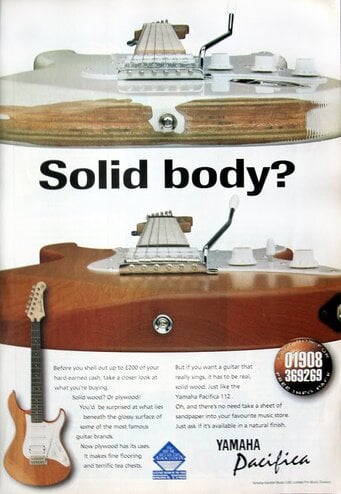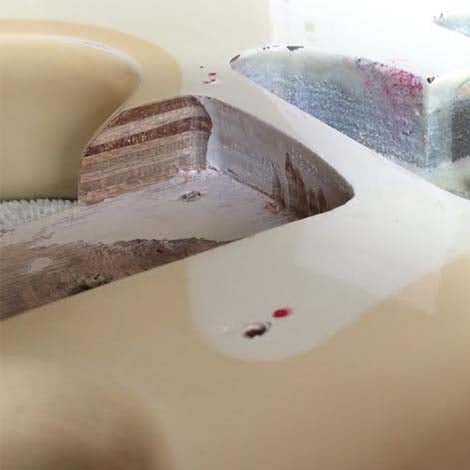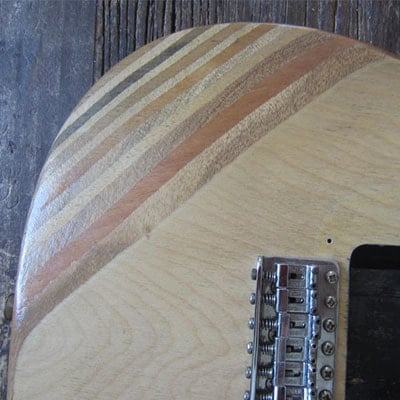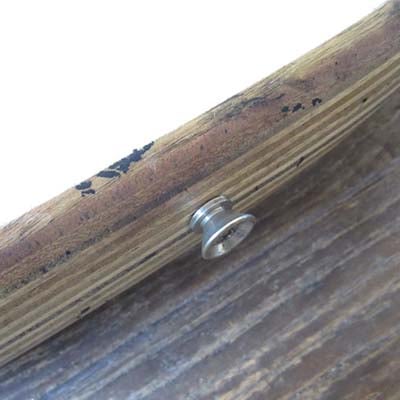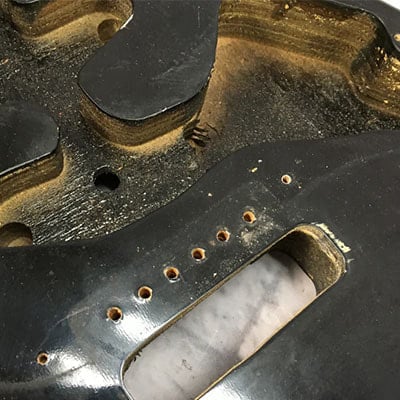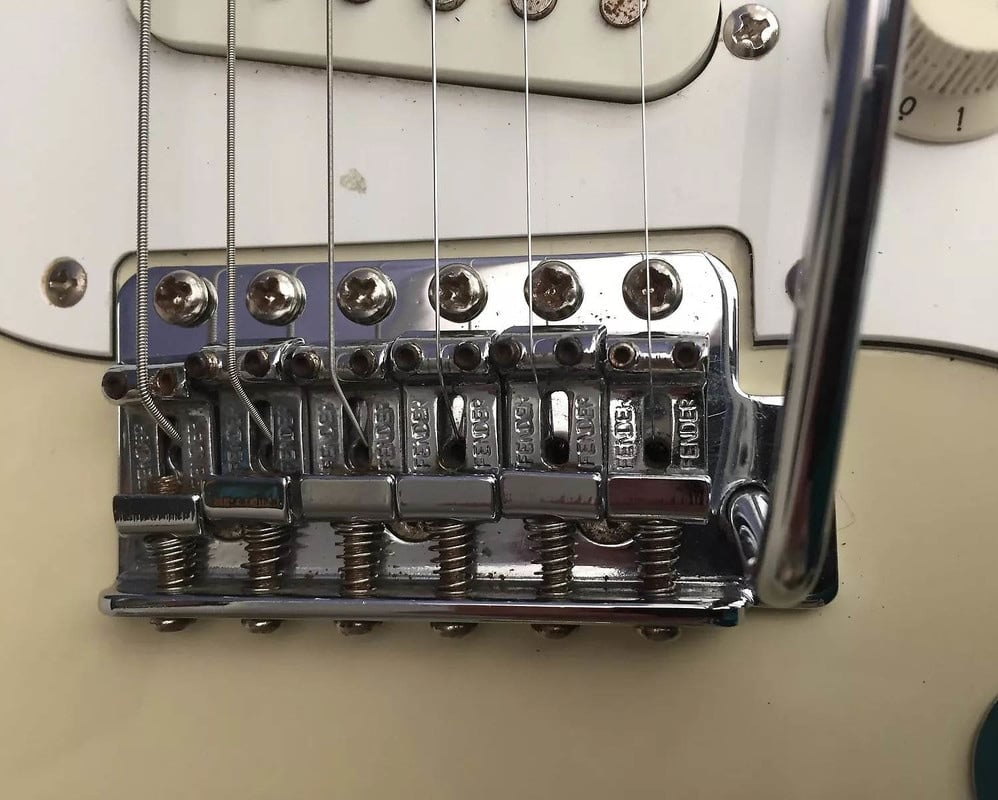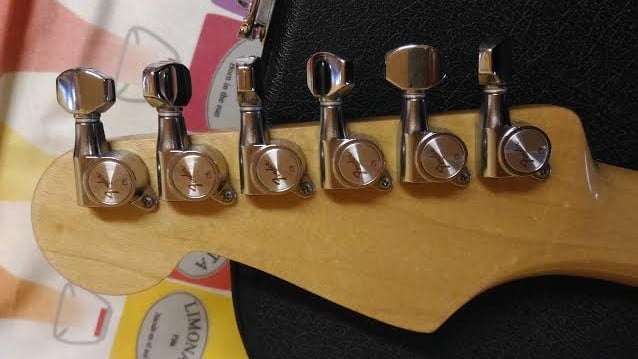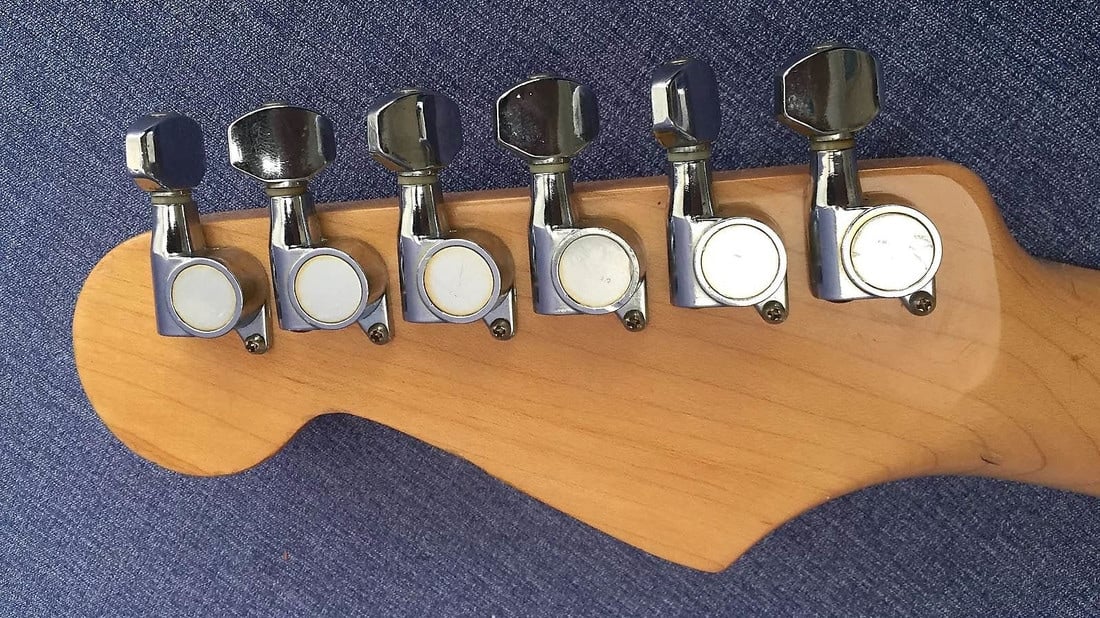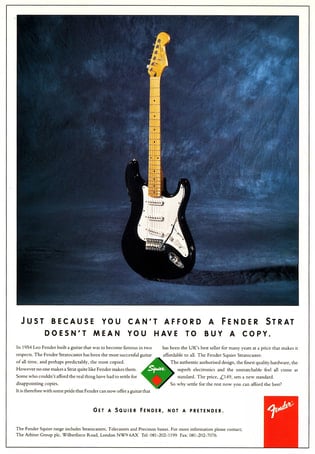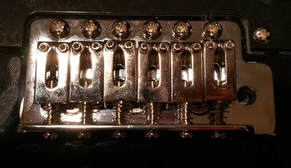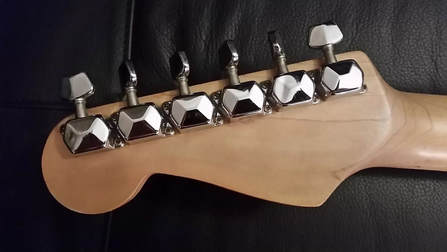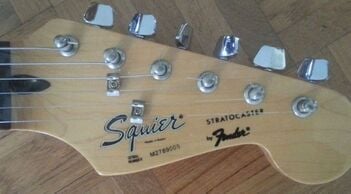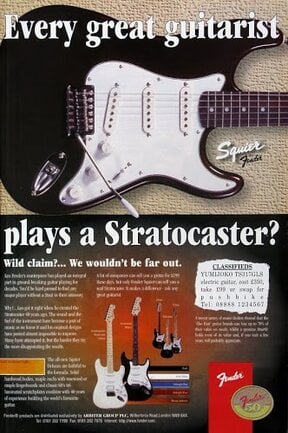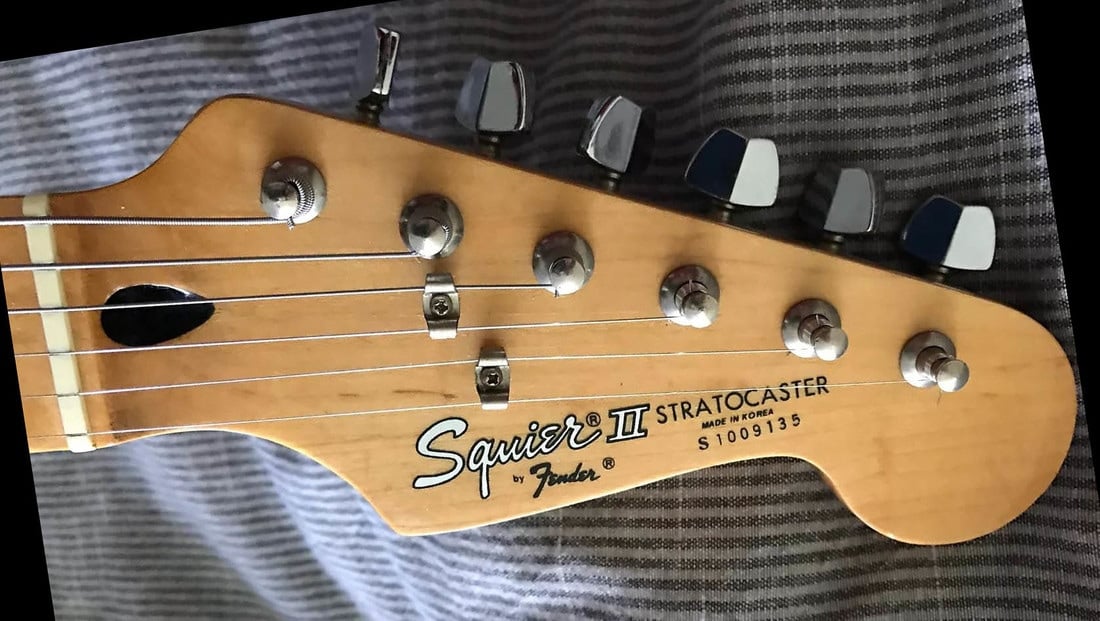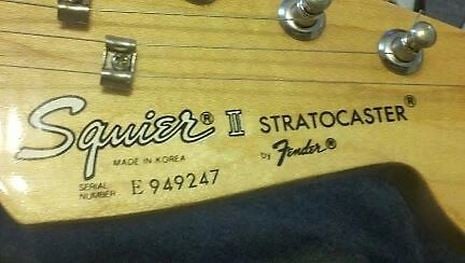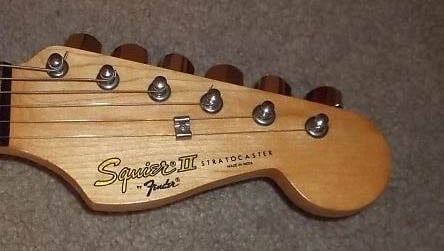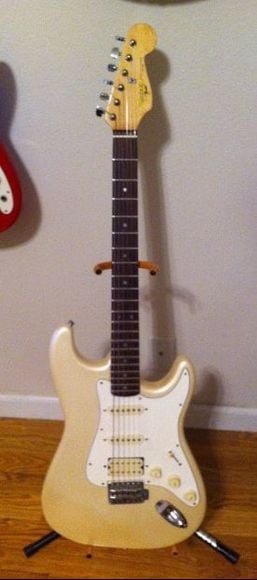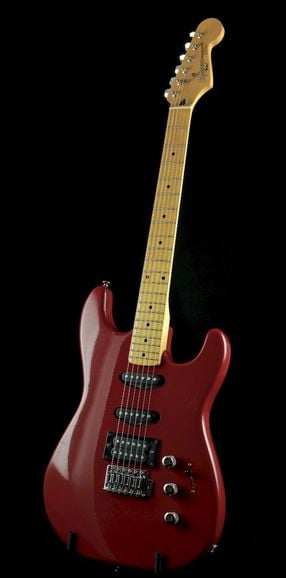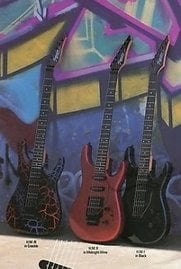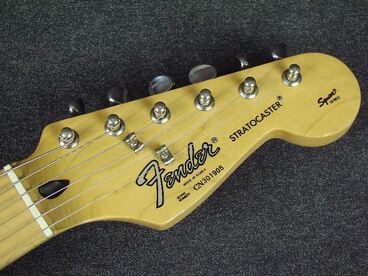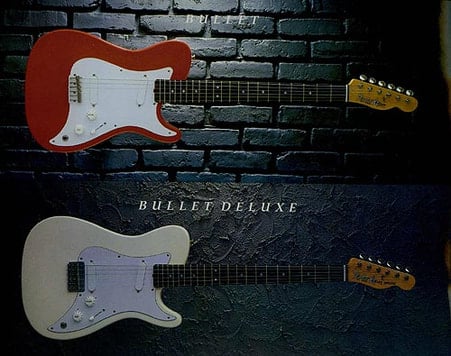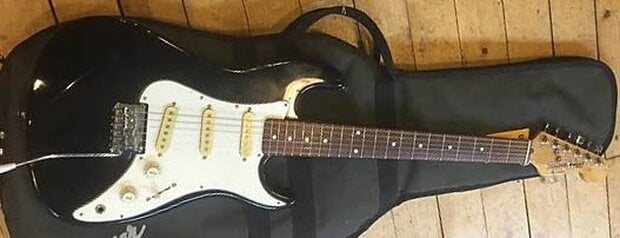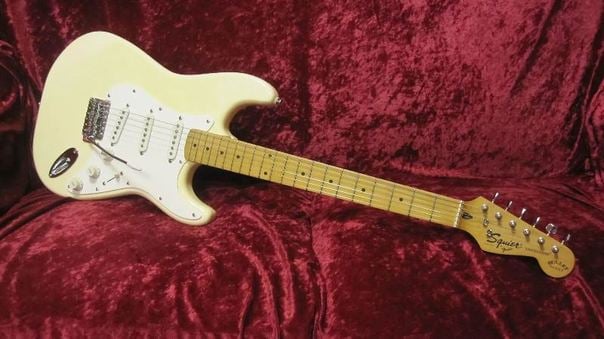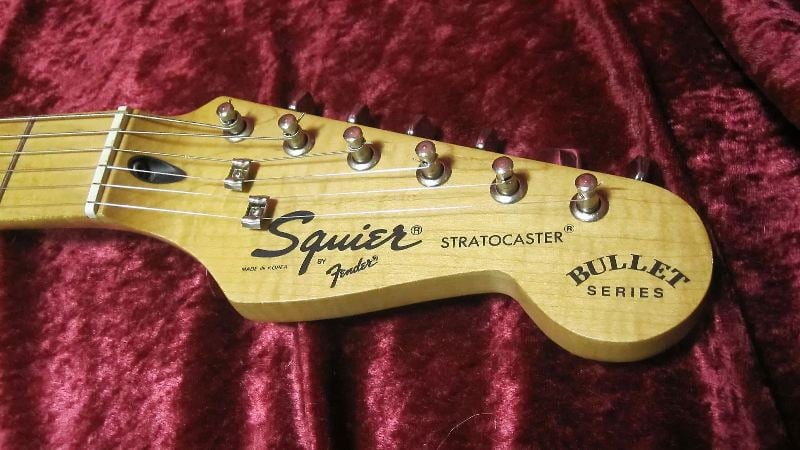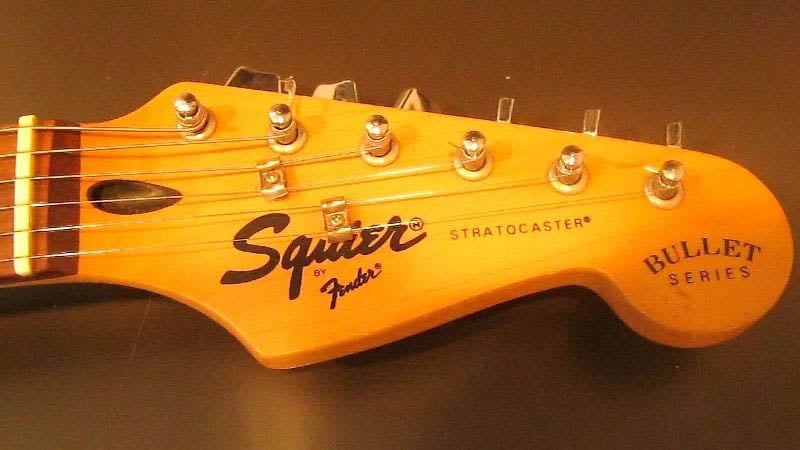THE FIRST KOREAN SQUIER STRATOCASTERS
Towards the end of the 1980s, prices of Japanese electric guitars were going up because manufacturers in Japan proved they could make great instruments, but the market was too competitive to tolerate that and they began to lose market share.
Therefore, even though Fender Japan continued to export some Fender-branded guitars and a few Squiers, in 1987 the Korean Young Chang factory, which had connections to the Japanese Moridaira firm, started to manufacture Squier Standard Stratocasters and soon became the main source of low-priced Squier guitars for North American and European markets (the last Japanese Squier Standard Stratocasters were sold in 1988).
These first Korean Stratocasters were recognizable by a very light silver serial number that started with E7, E1, or E9 (or, rarely, also E2 and E8) and by a small rectangular sticker attached to the neck heel and to the neck pocket.
Therefore, even though Fender Japan continued to export some Fender-branded guitars and a few Squiers, in 1987 the Korean Young Chang factory, which had connections to the Japanese Moridaira firm, started to manufacture Squier Standard Stratocasters and soon became the main source of low-priced Squier guitars for North American and European markets (the last Japanese Squier Standard Stratocasters were sold in 1988).
These first Korean Stratocasters were recognizable by a very light silver serial number that started with E7, E1, or E9 (or, rarely, also E2 and E8) and by a small rectangular sticker attached to the neck heel and to the neck pocket.
Young Chang stopped manufacturing Squier guitars around late 1988/early 1989 when production was moved to Sung Eum and Samick factories.
Sung Eum factory also used serial numbers that started with E9, but it was possible to distinguish them from those used on guitars manufactured in the Young Chang factory because the serial numbers used on guitars manufacatured in Sung Eum were always black.
The serial number of the guitars manufactured in the Samick factory had the S9 or S1 prefix and was also printed in black ink.
The tuning machines of the first Korean Squiers Stratocasters made in Young Chang were the Fender/Gotoh Standard type, like those used in Japan, while guitars built in Samick or Sung Eum were usually fitted with unbranded Standard tuners or with the cheaper Jin Ho covered tuning machines.
Early Squier Stratocasters, built in Young Chang, usually sported black roller string trees, while guitars built used in Samick or Sung Eum factories were butterfly-shaped.
Sung Eum factory also used serial numbers that started with E9, but it was possible to distinguish them from those used on guitars manufactured in the Young Chang factory because the serial numbers used on guitars manufacatured in Sung Eum were always black.
The serial number of the guitars manufactured in the Samick factory had the S9 or S1 prefix and was also printed in black ink.
The tuning machines of the first Korean Squiers Stratocasters made in Young Chang were the Fender/Gotoh Standard type, like those used in Japan, while guitars built in Samick or Sung Eum were usually fitted with unbranded Standard tuners or with the cheaper Jin Ho covered tuning machines.
Early Squier Stratocasters, built in Young Chang, usually sported black roller string trees, while guitars built used in Samick or Sung Eum factories were butterfly-shaped.
“Sometimes the guitars for the domestic market would come from one factory and the guitars for international sales would be produced by another,” Brad Townsend, Fender Vice President of international sales, recalls in an interview with Tony Bacon. “Sometimes one factory would have a quality issue or a delivery issue - since Fender wasn’t their only customer - and we would move production out of one into another. But eventually, Fender would end up doing business with that factory again, because there were basically only the three good factory choices.” Changes like this to the sources of guitars meant that it could be difficult to ensure consistency.
The Korean Squier Standard Stratocaster was listed for the first time in the US catalog in 1988 at a very competitive price ($299.99). At first, it was available in Black, Red, and White finishes, and then in Black, Midnight Wine, Arctic White, and Electric Blue.
The Korean Squier Contemporary Stratocaster was equipped with two single-coil and one humbucking pickup, a rosewood fretboard, and the Schaller Floyd Rose Licensed bridge with a locking nut. Its body had a side-mounted jack socked and was devoid of the pickguard. It was priced at $399.99 and the available finishes were Black, Razz Berry, Frost White, and Flash Pink.
The Korean Squier Contemporary Stratocaster was equipped with two single-coil and one humbucking pickup, a rosewood fretboard, and the Schaller Floyd Rose Licensed bridge with a locking nut. Its body had a side-mounted jack socked and was devoid of the pickguard. It was priced at $399.99 and the available finishes were Black, Razz Berry, Frost White, and Flash Pink.
After a promising start with good sales volumes, Korean strats did not, however, meet the expected success because the build quality had worsened considerably. The main reason for the decline of Squier guitars was the laminate construction of the body.
|
Although the first Korean guitars made in the Young Chang factory (with the silverish serial number) had a body made of a multi-piece alder core with a veneer top and back, those manufactured in Sung Eum and Samick (with a black serial number) had a plywood body hidden by thick polyester coats. The only exceptions to this rule were the Young Chang guitars with silverish E9 serial numbers, which had a plywood body.
Fender never mentioned body composition on their catalogs and price lists, but plywood bodies were an easy target for rival advertisers. In 1995 the Yamaha Pacifica advertisement showed a paint-stripped plywood Squier body and the tagline read: “Before you shell out up to £200 of your hard-earned cash, take a closer look at what you’re buying. Solid wood? Or plywood! You’d be surprised at what lies beneath the glossy surface of some of the most famous guitar brands. Now plywood has its uses. It makes fine flooring and terrific tea chests. But if you want a guitar that really sings, it has to be real, solid wood. Just like the Yamaha Pacifica 112. Oh, and there’s no need to take a sheet of sandpaper into your favourite music store. Just ask if it’s available in a natural finish.” |
The Korean plywood bodies, Courtesy of Evolution Music, Lil' Huddy's Guitar Shop and majestic5309 (Click to enlarge)
There is a widespread belief that the first MIK Squiers were assembled with leftover parts from the Japanese Fujigen Gakki factory. In reality, Fujigen continued to manufacture Fender “Standard” guitars, so there was no surplus stock to send to Korea. And, indeed, the differences between the Korean and Japanese Squiers were considerable: electronics, hardware, and pickups of the Korean guitars were cheaper, although a few hardware components came from a common source.
Someone also suggested that the saddles of the Korean Squiers came from the USA, but, apart from the contradiction implicit in this statement given that the FMIC wanted to lower the costs of MIKs, the double “Fender” stamps on the US saddles had reverse directions whilst those on Korean guitar had the same directions. In fact, according to John Page, saddles used on the Korean Squiers were produced in the Taiwanese Ping factory.
1992 SQUIER STANDARD AND CONTEMPORARY STRATOCASTERS
|
In 1992 the production was moved to Cor-Tek (Cort) and Saehan (Sunghan) factories and the new Squier guitars were recognizable by a new silkscreened black Squier logo and a serial number that started with CN and VN, respectively.
In order to lower costs and prices, the thickness of the plywood body of the Korean Stratocasters was reduced, as opposed to the full-size bodies of the guitars built in Young Chang, Samick, or Sung Eum. So, the new Squiers were not only made of plywood, but they were also smaller! Furthermore, the 1-ply pickguard was sometimes badly fitted and misaligned with the edges of the body. They also sported the cheap Jin Ho covered tuning machines, already used on some Stratocasters manufactured in Sung Eum factory. A low-budget bridge with thin die-cast block saddles replaced the vintage style bridge of the Squier Standard Stratocaster and the Floyd Rose Licensed bridge used on the Squier Contemporary Stratocaster, which became a sort of Standard HSS model. |
Both models were available with maple fingerboard only (at least until 1994) and the colors were reduced to Black, Arctic White, and Torino Red.
With the 1992 models, the Squier brand had really hit rock bottom.
With the 1992 models, the Squier brand had really hit rock bottom.
In 1994, the serial number was moved to the neck plate and the markings on the headstock were redesigned while maintaining the black Squier logo.
THE MISTERY OF THE M2 GUITARS
|
In 1992 a few Squier Standard (SSS) and Contemporary (HSS) Stratocasters featured a catchy black logo with silver trim and a serial number with an M2 prefix.
They had been probably made only for a very short period between the first and second series of the Korean Standard and Contemporary Stratocasters and little is known about these guitars. |
THE END OF THE PLYWOOD
|
The Korean Stratocasters were subject to severe negative marketing by their rivals because of their plywood body and Squier looked close to collapse, forcing Fender to completely rethink its strategy.
In 1996, Fender ran for cover and redesigned Squier guitars, replacing their thin plywood body with a thicker one made of alder, available in Midnight Blue, Midnight Wine, Black, Arctic White, and Brown Sunburst finishes, and using a 3-ply pickguard that fitted better to the body and a much more efficient Synchronous Tremolo with die-cast CBS style saddles. They were available in the SSS and HSS (now called Squier Standard Fat Stratocaster instead of Contemporary) models. To point out all these changes, a new Gold Logo was applied on the headstock. |
|
In spite of everything, they were not well built (it wasn’t sufficient to change the body to make them better), so Fender introduced new “deluxe” Squier models to complement the cheaper Squier Standard series, the Pro Tone Series (see next chapter), which only cost a little more.
It should also be remembered that in late 1994 Fender started to make some Squier guitars in China and in 1998, for only a few months, the production of the Standard Squiers was temporarily moved to Mexico, where the “Black Label” Squier Classic Stratocaster and the Mexican Fender Squier Series, had been made some years before. |
SQUIER II: MADE IN KOREA AND MADE IN INDIA
With the intent to offer instruments at an even more affordable price, in 1988 Fender made a brief attempt to manufacture guitars in India, at the Greeta factory in Madras (now Chennai), adopting the Squier II brand name.
The Indian Squier II Stratocasters were recognizable by the weird shape of both their headstock and pickguard. Their quality was inconsistent and it seems that Fender destroyed more of them than it shipped. In a letter to dealers, dated September 1988, Fender apologized for the mess, saying that supply is going to be drastically less than what they planned.
Therefore, the production of Squier II guitars was moved to the Samick factory in Korea, some through a deal with Texas-based distributor IMC, but they were discontinued between 1992 and 1993.
Squier II body, available in Black, Torino Red, and Frost White, was in plywood even though the Fender catalog reported “hardwood,” and it was thin and usually heavier than that of the other Korean guitars, and the hardware was definitely cheap.
The Squier II Standard Stratocaster was available in both SSS (made in Korea and India) and HSS (only made in India) versions.
The Squier II Contemporary Stratocaster, equipped with one humbucker and two single coils, was solely manufactured in Korea. It differed from Squier II Standard HSS Stratocaster by the absence of the pickguard and the side-mounted jack socket.
The Indian instruments did not always have the “Made in India” marking on the headstock, while their serial number, which followed a US-style serialization scheme (“E” for the '80s and “N” for the '90s), was printed on a sticker attached to the base of the neck that often peeled off.
The serial number of the Korean Squier II Stratocasters was black and located on the headstock and began with an E9, S9, S1, J1, or M1 prefix, depending on the production plant.
The Indian Squier II Stratocasters were recognizable by the weird shape of both their headstock and pickguard. Their quality was inconsistent and it seems that Fender destroyed more of them than it shipped. In a letter to dealers, dated September 1988, Fender apologized for the mess, saying that supply is going to be drastically less than what they planned.
Therefore, the production of Squier II guitars was moved to the Samick factory in Korea, some through a deal with Texas-based distributor IMC, but they were discontinued between 1992 and 1993.
Squier II body, available in Black, Torino Red, and Frost White, was in plywood even though the Fender catalog reported “hardwood,” and it was thin and usually heavier than that of the other Korean guitars, and the hardware was definitely cheap.
The Squier II Standard Stratocaster was available in both SSS (made in Korea and India) and HSS (only made in India) versions.
The Squier II Contemporary Stratocaster, equipped with one humbucker and two single coils, was solely manufactured in Korea. It differed from Squier II Standard HSS Stratocaster by the absence of the pickguard and the side-mounted jack socket.
The Indian instruments did not always have the “Made in India” marking on the headstock, while their serial number, which followed a US-style serialization scheme (“E” for the '80s and “N” for the '90s), was printed on a sticker attached to the base of the neck that often peeled off.
The serial number of the Korean Squier II Stratocasters was black and located on the headstock and began with an E9, S9, S1, J1, or M1 prefix, depending on the production plant.
SQUIER HM STRAT
|
The HM Strats were not only Japanese guitars: between 1989 and 1992 also Korea carried out five models of these superstrats, all of them with a small body, twenty-two frets, black hardware, less pickguard, and equipped with a 2-pivot bridge, under Floyd Rose license, or, from 1991 on, an authentic Floyd Rose. The headstock was very distinctive: aggressive, edgy, and with a big "Swooshy" Squier logo.
The HM I and HM II had one humbucker and two single coils; the HM III, HM IV, and HM V had two humbuckers and one single coil. The neck of the I, II, and III was screwed to the body through a 4-bolt contoured neck plate; on the contrary, IV and V were neck-through. Unfortunately, even these guitars were of far lesser quality than the Japanese versions. |
KOREAN SQUIER SERIES STRATOCASTER
|
In 1992 Fender launched the Fender Squier Series Stratocaster in an attempt to revive the Korean Squier guitars. This Fender branded guitar featured a small Squier Series logo on the tip of the headstock and is not to be confused with the Japanese and the Mexican Fender Squier Series Stratocasters.
According to Fender, the Squier Series Stratocaster was a step above the other Squier guitars, as the advertisement said: “For musicians who want the quality and the performance of a Fender guitar but don't think they can afford it, the Fender Squier Series is the answer.” It was available in Black, Torino Red, Arctic White, and also in the catchy Pacific Blue finish. |
However, a vintage-style bridge, a 3-ply pickguard, and the Fender logo on the headstock were not enough to revive the Korean Squiers.
THE BULLET STRATOCASTERS
|
The Fender Bullet was a guitar designed by John Page conceived for a young and novice budget-minded public to replace the outgoing Mustang and the Music Master.
Fender initially intended to have the Bullet manufactured offshore in Korea, but it did not work out due to some quality control issues, and the first two models, the Bullet (known as “Standard Bullet”) and the Bullet Deluxe, were made in the USA at the Fullerton plant between 1981 and mid-1982. By late 1983, Fender decided to relocate the production of Bullet guitars to Japan and market them under the Squier brand. |
Japanese Squier Bullet guitars featured solid wood bodies and ceramic pickups, and they no longer had strings-through-body bridges.
The available finishes included Black and Sunburst. Some of these guitars had serial numbers that began with “SQ,” while others started with “E”. The available models included the Squier Bullet H-2, Squier Bullet S-3, Squier Bullet S-3T (two versions), and the Squier Contemporary Bullet HST.
The available finishes included Black and Sunburst. Some of these guitars had serial numbers that began with “SQ,” while others started with “E”. The available models included the Squier Bullet H-2, Squier Bullet S-3, Squier Bullet S-3T (two versions), and the Squier Contemporary Bullet HST.
In 1987, production of the Bullets was shifted to Korea, updating the Squier Bullet S-3T and the Squier Contemporary Bullet HST (two versions), and introducing the Squier Contemporary Bullet HSS.
It's important to note that, up to this point, the Bullet series was not yet a type of Stratocaster, although the 1987 Korean S-3T models bore a strong resemblance to it. The first true Bullet series Stratocaster was the Squier Bullet Stratocaster, which was manufactured in Korea starting from 1989.
It was an affordable guitar that, in line with Korean manufacturing, featured a plywood body.
The tuning machines were the budget Ping models, replacing the previous 'Fender stamped' tuners found on the Japanese Bullets. The two-pivot bridge had die-cast saddles, and the pickguard had an unconventional shape reminiscent of Indian Stratocasters. This guitar lacked the second tone knob, and in its place, there was a jack socket.
It was an affordable guitar that, in line with Korean manufacturing, featured a plywood body.
The tuning machines were the budget Ping models, replacing the previous 'Fender stamped' tuners found on the Japanese Bullets. The two-pivot bridge had die-cast saddles, and the pickguard had an unconventional shape reminiscent of Indian Stratocasters. This guitar lacked the second tone knob, and in its place, there was a jack socket.
The serial number of the very first Bullet Stratocasters was stamped on the neck plate and featured an “E9” prefix. The headstock sported the Silver Squier Logo along with a silver star near the Fender logo and the 'Bullet' inscription. Initially, it was equipped with only one string tree. However, the serial number was soon relocated to the headstock, and a second string tree was added afterward.
The next Squier Bullet Stratocaster, produced between 1994 and 1995, stood out from its predecessor due to several distinct features. These included a bridge with six screws, a headstock featuring the Black Squier Logo along with the "BULLET SERIES" decal, two string trees, and, most notably, the inclusion of a second tone control.
Later on, the production of the Bullets was moved to China and Indonesia, but no longer in Korea.
Later on, the production of the Bullets was moved to China and Indonesia, but no longer in Korea.
Antonio Calvosa
